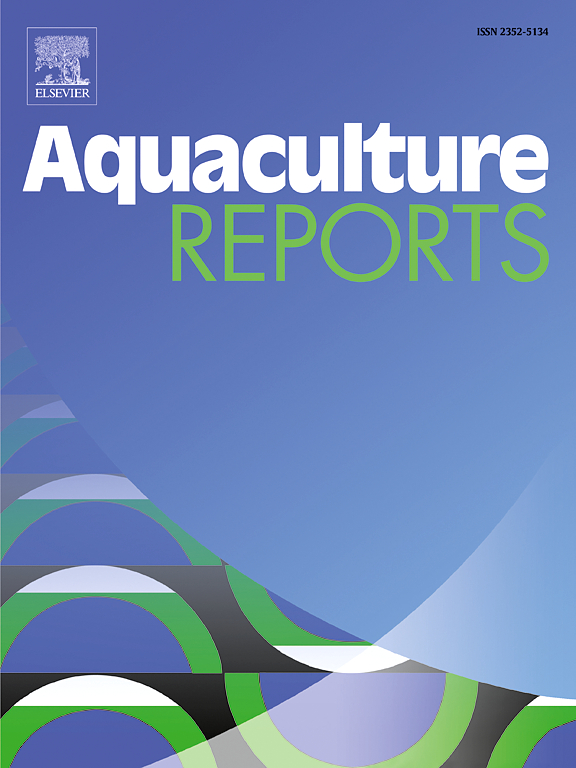C-type lectin (SpCTL) through its binding to Spβ-integrin regulates antimicrobial peptide synthesis in mud crab (Scylla paramamosain) during Vibrio parahaemolyticus infection
IF 3.2
2区 农林科学
Q1 FISHERIES
引用次数: 0
Abstract
C-type lectin (CTL) is a widespread pattern recognition receptor that recognizes and binds to pathogen-associated molecular patterns on the surface of pathogens and mediates a series of immune responses in animals. In this study, the mud crab SpCTL cDNA was cloned and functionally characterized. Phylogenetic analysis showed that SpCTL was closely related to Eriocheir sinensis with 81 % homology. The SpCTL mRNA was expressed in hemocytes and hepatopancreas under infection with Vibrio parahaemolyticus (Vp), lipopolysaccharide (LPS), white spot syndrome virus (WSSV), or Poly I: C (PIC). Furthermore, the recombinant SpCTL (rSpCTL) protein was purified, and the antimicrobial activity of rSpCTL was analyzed. The results showed that the rSpCTL had an agglutination activity on Staphylococcus aureus, Streptococcus b, Escherichia coli, Vp, Aeromonas hydrophila, Vibrio alginolyticus, and Saccharomyces cerevisiae in the presence of calcium ions. rSpCTL showed strong adhesion to Streptococcus b, E. coli and V. alginolyticus. Also, rSpCTL revealed good bacteriostatic activity on S. aureus, Streptococcus b, E. coli, Vp, A. hydrophila, and V. alginolyticus, with a dose-dependent manner, but not on S. cerevisiae. Besides, the mass spectrometry results showed that the expression of Spβ-integrin and Spflotillin-2 (SpFLT-2) was significantly down-regulated at 6, 24, and 48 h when the expression of SpCTL was knocked down by RNAi, whereas the change of FLT-2 was not significant (first up-regulated and then down-regulated) at 6 and 24 h. Our results found that under stimulation of Vp, SpCTL recognizes the bacterium and binds to Spβ-integrin, which transmits signals into hemocyte and subsequently regulates the expression of antimicrobial peptides (SpALF1, SpALF3–5) and protects mud crabs from infection. Collectively, the results indicate that SpCTL has agglutination, bacteriostatic, and adhesion activities. SpCTL play an important role in the innate immunity of mud crabs.
c型凝集素(SpCTL)通过与sp β-整合素的结合调节副溶血性弧菌感染期间泥蟹(Scylla paramamosain)抗菌肽的合成
c型凝集素(CTL)是一种广泛存在的模式识别受体,可识别并结合病原体表面的病原体相关分子模式,并介导动物的一系列免疫反应。本研究克隆了泥蟹SpCTL cDNA,并对其进行了功能鉴定。系统发育分析表明,SpCTL与中华绒螯蟹亲缘关系密切,同源性为81% %。SpCTL mRNA在副溶血性弧菌(Vp)、脂多糖(LPS)、白斑综合征病毒(WSSV)或聚I: C (PIC)感染的血细胞和肝胰腺中表达。纯化了重组SpCTL (rSpCTL)蛋白,并对其抑菌活性进行了分析。结果表明,在钙离子存在下,rSpCTL对金黄色葡萄球菌、b型链球菌、大肠杆菌、Vp、嗜水气单胞菌、溶藻弧菌和酿酒酵母具有凝集活性。rSpCTL对b型链球菌、大肠杆菌和溶藻弧菌具有较强的粘附性。此外,rSpCTL对金黄色葡萄球菌、b型链球菌、大肠杆菌、Vp、嗜水单胞菌和溶藻弧菌具有良好的抑菌活性,且呈剂量依赖性,但对酿酒葡萄球菌没有抑制作用。质谱分析结果显示,当RNAi敲除SpCTL表达时,Spβ-integrin和Spflotillin-2 (SpFLT-2)在6、24和48 h时表达显著下调,而FLT-2在6和24 h时变化不显著(先上调后下调)。我们的研究结果发现,在Vp的刺激下,SpCTL识别细菌并结合sp β-整合素,将信号传递到血细胞中,随后调节抗菌肽(SpALF1, SpALF3-5)的表达,保护泥蟹免受感染。综上所述,SpCTL具有凝集、抑菌和粘附活性。SpCTL在泥蟹的先天免疫中起重要作用。
本文章由计算机程序翻译,如有差异,请以英文原文为准。
求助全文
约1分钟内获得全文
求助全文
来源期刊

Aquaculture Reports
Agricultural and Biological Sciences-Animal Science and Zoology
CiteScore
5.90
自引率
8.10%
发文量
469
审稿时长
77 days
期刊介绍:
Aquaculture Reports will publish original research papers and reviews documenting outstanding science with a regional context and focus, answering the need for high quality information on novel species, systems and regions in emerging areas of aquaculture research and development, such as integrated multi-trophic aquaculture, urban aquaculture, ornamental, unfed aquaculture, offshore aquaculture and others. Papers having industry research as priority and encompassing product development research or current industry practice are encouraged.
 求助内容:
求助内容: 应助结果提醒方式:
应助结果提醒方式:


